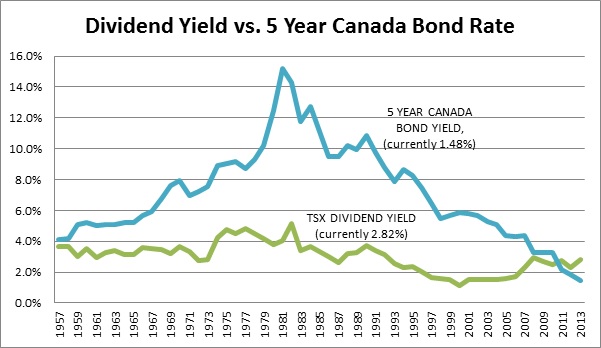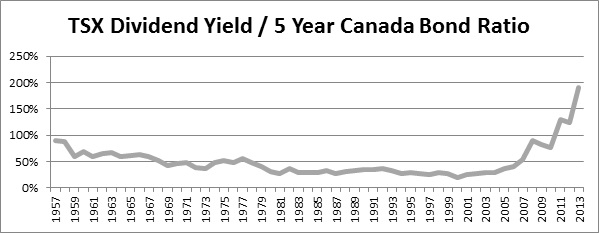Asset allocation, which sounds pretty boring, is much more important than stock picking. Deciding how much of a portfolio to put into cash, into bonds, and into stocks, has a huge effect on returns over time. One of the key factors in determining optimal asset allocation is interest rates. That brings us to the three crucial questions of the moment: when will interest rates go up, how much will they go up, and what should we do about it?
When interest rates are high, conservative investors can buy the safest securities such as GICs and Government bonds, and live off the income they produce. When they are low, as they have been the past four years, the income investors receive drops sharply, and riskier investments such as common shares become more attractive.
This graph shows the income yield from the 5 year Canada bond over the past fifty–sixty years, compared to the dividend yield from all stocks in the TSX/S&P Index:
It is easy to see why even very conservative investors were driven out of bonds. With the interest rate on the bond falling from over 5% ten years ago to under 1.5% today, fixed income simply does not produce enough income. Couple the low interest rates with high tax rates (interest is taxed at the highest marginal rate) and bond investors are faced with post-tax yields of under 1%, less than inflation. At the same time, the dividend yield on the TSX is rising, from about 1.8% ten years ago to about 2.8% today. With the dividend tax credit, the post-tax dividend yield is almost three times the post-tax yield on bonds.
In fact, the relationship between interest rates and dividend yields has been turned on its head. Normally, dividends on the major blue chip stocks – shares of banks, telecommunications companies, utilities and pipelines – are considerably less than the interest on medium term bonds. For the past ten years, the ratio of dividend yield to interest yield has been rising, and is now at a record high.
Dividend yields are now almost twice as high, before taxes, as bond yields.
This has been one of the reasons behind the recent upward movement in the stock markets in both Canada and the US.
In late May, as a result of better than expected strength in the U.S. economy, and due to comments made by Ben Bernanke, Chairman of the Federal Reserve Bank in the U.S., investors began to fear that interest rates would begin to rise. Bond prices did indeed increase somewhat. We saw a huge sell-off of dividend payers in the Canadian stock market in the last three days of the month. All of the stocks which investors had run to for yield were suddenly unattractive, and were sold. But yet, even with the recent increase, bond yields remain far below normal levels.
In fact, the five year Canada bond yield is just about the same as it was in both August 2011 and August 2012. It is hard to understand any good reason for the selling panic we saw in the last days of May.
It is obvious that interest rates will go up at some point. The current record low rates are a result of the severe recession in the world economy in the 2008 to 2010 period. We expect that within a few years, five at the outside, the five year Canada bond will be back up to a yield of 4% to 6%, much more typical of the past fifty years. Does this mean that investors should flee the stock market?
Not in our view. The rise in rates will be slow and gradual. Central bankers cannot risk throwing the major world economies back into recession by imposing high borrowing costs on deeply indebted governments. Both the U.S. Federal Reserve and the Bank of Canada have recently adopted a policy of giving business and investors very explicit messages to facilitate forward planning. For this reason, we know that short term rates (90 days and less) will not rise more than say ¼ of 1% in the next year, and not more than 1% in the next two years. Longer rates will rise somewhat more, and perhaps somewhat faster, but there will be no fast and furious increases.
Secondly, rates can rise a long way before the dividend yields on stocks become unattractive. For example, with yields of about 4% on average, the major Canadian banks are paying more than twice the Canada five year bond yield. If the five year bond rises to 5%, the bank dividends will be almost back to their normal level compared to bond yields. As noted above, this is not likely to happen before 2016.
Finally, good quality companies keep increasing their dividends and continue to buy back their own shares. Two of the banks hiked dividends this quarter, and it is likely that three more will do so before the end of the year. The same is true of the telecoms (all of BCE (BCE), Telus (TU) and Rogers (RCI) have raised their dividend this year), utilities, pipelines and REITs. Simply put, rising dividends on top of already high yields is an unbeatable combination.
There is no question that investors exhibited characteristic over-exuberance in pushing up the prices of some high yield stocks. This is normal; the pendulum always swings too far in the stock market, both on the high end, and on the low end. At the end of May the selling was overdone. We see no reason to exit from high dividend stocks at this time, and unless something important changes, very little reason to fear them over the next two years or so.
Disclosure: The author and/or household family members own stocks mentioned in this post. Clients of Baskin Financial own all stocks mentioned in this post.
- English (UK)
- English (India)
- English (Canada)
- English (Australia)
- English (South Africa)
- English (Philippines)
- English (Nigeria)
- Deutsch
- Español (España)
- Español (México)
- Français
- Italiano
- Nederlands
- Português (Portugal)
- Polski
- Português (Brasil)
- Русский
- Türkçe
- العربية
- Ελληνικά
- Svenska
- Suomi
- עברית
- 日本語
- 한국어
- 简体中文
- 繁體中文
- Bahasa Indonesia
- Bahasa Melayu
- ไทย
- Tiếng Việt
- हिंदी
Keep The Faith With Dividend Stocks
Published 06/04/2013, 12:28 AM
Updated 07/09/2023, 06:31 AM
Keep The Faith With Dividend Stocks
Latest comments
Loading next article…
Install Our App
Risk Disclosure: Trading in financial instruments and/or cryptocurrencies involves high risks including the risk of losing some, or all, of your investment amount, and may not be suitable for all investors. Prices of cryptocurrencies are extremely volatile and may be affected by external factors such as financial, regulatory or political events. Trading on margin increases the financial risks.
Before deciding to trade in financial instrument or cryptocurrencies you should be fully informed of the risks and costs associated with trading the financial markets, carefully consider your investment objectives, level of experience, and risk appetite, and seek professional advice where needed.
Fusion Media would like to remind you that the data contained in this website is not necessarily real-time nor accurate. The data and prices on the website are not necessarily provided by any market or exchange, but may be provided by market makers, and so prices may not be accurate and may differ from the actual price at any given market, meaning prices are indicative and not appropriate for trading purposes. Fusion Media and any provider of the data contained in this website will not accept liability for any loss or damage as a result of your trading, or your reliance on the information contained within this website.
It is prohibited to use, store, reproduce, display, modify, transmit or distribute the data contained in this website without the explicit prior written permission of Fusion Media and/or the data provider. All intellectual property rights are reserved by the providers and/or the exchange providing the data contained in this website.
Fusion Media may be compensated by the advertisers that appear on the website, based on your interaction with the advertisements or advertisers.
Before deciding to trade in financial instrument or cryptocurrencies you should be fully informed of the risks and costs associated with trading the financial markets, carefully consider your investment objectives, level of experience, and risk appetite, and seek professional advice where needed.
Fusion Media would like to remind you that the data contained in this website is not necessarily real-time nor accurate. The data and prices on the website are not necessarily provided by any market or exchange, but may be provided by market makers, and so prices may not be accurate and may differ from the actual price at any given market, meaning prices are indicative and not appropriate for trading purposes. Fusion Media and any provider of the data contained in this website will not accept liability for any loss or damage as a result of your trading, or your reliance on the information contained within this website.
It is prohibited to use, store, reproduce, display, modify, transmit or distribute the data contained in this website without the explicit prior written permission of Fusion Media and/or the data provider. All intellectual property rights are reserved by the providers and/or the exchange providing the data contained in this website.
Fusion Media may be compensated by the advertisers that appear on the website, based on your interaction with the advertisements or advertisers.
© 2007-2024 - Fusion Media Limited. All Rights Reserved.
